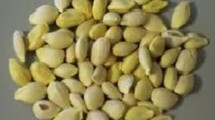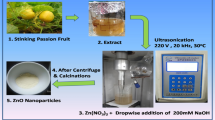Abstract
The green biogenic production of nanoparticles from natural sources is always desirable due to its minimal environmental effect. In this study, the generation of ZrO2 nanoparticles from the aqueous leaf extract of Eichhornia crassipes was the major emphasis. It is a notable weed that poses a threat to aquatic life and the environment owing to its proclivity to cover the whole water surface and is a major environmental hazard. Synthesized ZrO2 nanoparticles were characterized by using UV–visible, Fourier Transform Infrared Spectroscopy (FTIR), X-Ray Diffraction (XRD), and Scanning Electron Microscopy (SEM). Characterization methods validated the creation of ZrO2 nanoparticles. Narrow peaks with sharp edges indicated a considerable rise in the zirconia nanoparticle’s crystalline index when XRD analysis was done on them. The nanoparticles were then utilized for treating wastewater containing industrial dyes, i.e., Methyl Orange and Methylene Blue. The results indicated maximum removal of COD, BOD, nitrate, and phosphate along with highest degradation of these industrial dyes. The removal efficiency of 72.63% COD, 73.06% of BOD, 84.64% nitrate, and 90.30% phosphate was obtained in wastewater. Moreover, the highest degradation of Methylene Blue and Methylene Orange was found at 40 ppm concentration using 0.02% of ZrO2 nanoparticles. This study shows that biogenically produced nanoparticles were found to possess a great degrading capacity for treatment of Methyl Orange and Methylene Blue.








Similar content being viewed by others
Data availability
Data available on request.
References
Aboelfetoh EF, Gemeay AH, El-Sharkawy RG (2020) Effective disposal of methylene blue using green immobilized silver nanoparticles on graphene oxide and reduced graphene oxide sheets through one-pot synthesis. Environ Monit Assess 192:1–20
Hussain MK, Khalid NR (2022) Surfactant-assisted synthesis of MoO3 nanorods and its application in photocatalytic degradation of different dyes in aqueous environment. J Mol Liq 346:117871
Wenjie Z, Zhou C, Zhou W, Lei A, Zhang Q, Wan Q, Zou B (2011) Fast and considerable adsorption of methylene blue dye onto graphene oxide. Bull Environ Contam Toxicol 87:86–90
Pandit C, Roy A, Ghotekar S, Khusro A, Islam MN, Emran TB, Lam SE, Khandaker MU, Bradley DA (2022) Biological agents for synthesis of nanoparticles and their applications. J King Saud Univ Sci 34(3):101869
Mandal AK, Katuwal S, Tettey F, Gupta A, Bhattarai S, Jaisi S, Bhandari DP, Shah AK, Bhattarai N, Parajuli N (2022) Current research on zinc oxide nanoparticles: synthesis, characterization, and biomedical applications. Nanomaterials 12(17):3066
Ahmad W, Joshi HC, Pandey S, Kumar V, Verma M (2022) An overview of green methods for Fe2O3 nanoparticle synthesis and their applications. Int Nano Lett 3:1–4
Jeevanandam J, Kiew SF, Boakye-Ansah S, Lau SY, Barhoum A, Danquah MK, Rodrigues J (2022) Green approaches for the synthesis of metal and metal oxide nanoparticles using microbial and plant extracts. Nanoscale 14(7):2534–2571
Dersseh MG, Melesse AM, Tilahun SA, Abate M, Dagnew DC (2019) Water hyacinth: review of its impacts on hydrology and ecosystem services—lessons for management of Lake Tana. Extreme hydrology and climate variability. 1:237-51
Lima JR, De Farias DL, Menezes TH, Oliveira RV, Silva IA, da Costa CG, Romão LP (2020) Potential of a magnetic hybrid material produced using water hyacinth (Eichhornia crassipes) for removal of inorganic and organic pollutants from aqueous media. J Environ Chem Eng 8(5):104100
Lalitha P, Sripathi SK, Jayanthi P (2012) Secondary metabolites of Eichhornia crassipes (water hyacinth): a review (1949 to 2011). Nat Prod Commun 7(9):1934578X1200700939
Das S, Goswami S, Talukdar AD (2016) Physiological responses of water hyacinth, Eichhornia crassipes (Mart.) Solms, to cadmium and its phytoremediation potential. Turk J Biol 40(1):84–94
Auchterlonie J, Eden CL, Sheridan C (2021) The phytoremediation potential of water hyacinth: a case study from Hartbeespoort Dam, South Africa. S Afr J Chem Eng 37:31–36
Rezania S, Ponraj M, Talaiekhozani A, Mohamad SE, Din MF, Taib SM, Sabbagh F, Sairan FM (2015) Perspectives of phytoremediation using water hyacinth for removal of heavy metals, organic and inorganic pollutants in wastewater. J Environ Manage 163:125–133
Joseph L, Jun BM, Flora JR, Park CM, Yoon Y (2019) Removal of heavy metals from water sources in the develo** world using low-cost materials: a review. Chemosphere 229:142–159
Mannaa MA, Qasim KF, Alshorifi FT, El-Bahy SM, Salama RS (2021) Role of NiO nanoparticles in enhancing structure properties of TiO2 and its applications in photodegradation and hydrogen evolution. ACS Omega 6(45):30386–30400
El-Hakam SA, ALShorifi FT, Salama RS, Gamal S, El-Yazeed WA, Ibrahim AA, Ahmed AI (2022) Application of nanostructured mesoporous silica/bismuth vanadate composite catalysts for the degradation of methylene blue and brilliant green. J Mater Res Technol 18:1963–1976
Saleh TS, Badawi AK, Salama RS, Mostafa MMM (2023) Design and development of novel composites containing nickel ferrites supported on activated carbon derived from agricultural wastes and its application in water remediation. Materials 16(6):2170
Alasri, T. M., Ali, S. L., Salama, R. S., & Alshorifi, F. T. (2023). Band-structure engineering of TiO2 photocatalyst by AuSe quantum dots for efficient degradation of malachite green and phenol. J Inorg Organomet Polym Mater, 1–12
Vinu D, Govindaraju K, Vasantharaja R, Amreen Nisa S, Kannan M, Vijai Anand K (2021) Biogenic zinc oxide, copper oxide and selenium nanoparticles: preparation, characterization and their anti-bacterial activity against Vibrio parahaemolyticus. J Nanostruct Chem 11:271–286
Omidi S, Sedaghat S, Tahvildari K, Derakhshi P, Motiee F (2018) Biosynthesis of silver nanocomposite with Tarragon leaf extract and assessment of antibacterial activity. J Nanostruct Chem 8:171–178
Pandey, S., Singh, A., Ahmad, W., Panwar, R., & Anand, S. (2023). Aquatic weed derived SnO2 nanoparticle: synthesis, characterization and its application for degradation of dyes and wastewater treatment. Asian J Chem
Muthuvel A, Jothibas M, Manoharan C (2020) Synthesis of copper oxide nanoparticles by chemical and biogenic methods: photocatalytic degradation and in vitro antioxidant activity. Nanotechnol Environ Eng 5:1–19
Shinde HM, Bhosale TT, Gavade NL, Babar SB, Kamble RJ, Shirke BS, Garadkar KM (2018) Biosynthesis of ZrO2 nanoparticles from Ficus benghalensis leaf extract for photocatalytic activity. J Mater Sci: Mater Electron 29:14055–14064
Muthulakshmi N, Kathirvel A, Subramanian R, Senthil M (2023) Biofabrication of zirconia nanoparticles: synthesis spectral characterization and biological activity evaluation against pathogenic bacteria. Biointerface Res Appl Chem 13:190
Saraswathi VS, Santhakumar K (2017) Photocatalytic activity against azo dye and cytotoxicity on MCF-7 cell lines of zirconium oxide nanoparticle mediated using leaves of Lagerstroemia speciosa. J Photochem Photobiol, B 169:47–55
Horti NC, Kamatagi MD, Nataraj SK, Wari MN, Inamdar SR (2020) Structural and optical properties of zirconium oxide (ZrO2) nanoparticles: effect of calcination temperature. Nano Express 1(1):010022
Kumar S, Bhunia S, Ojha AK (2015) Effect of calcination temperature on phase transformation, structural and optical properties of sol-gel derived ZrO2 nanostructures. Physica E 66:74–80
Turki Jalil A, Emad Al Qurabiy H, Hussain Dilfy S, Oudah Meza S, Aravindhan SM, Kadhim MM, Aljeboree A (2021) CuO/ZrO2 nanocomposites: facile synthesis, characterization and photocatalytic degradation of tetracycline antibiotic. J Nanostruct 11(2):333–346. https://doi.org/10.22052/JNS.2021.02.014
Sikdar S, Banu A, Ali S, Barman S, Kalar PL, Das R (2022) Micro-structural analysis and photocatalytic properties of green synthesized t-ZrO2 nanoparticles. Chemistry 7(4):202103953
Haq S, Shoukat S, Rehman W, Waseem M, Shah A (2020) Green fabrication and physicochemical investigations of zinc-cobalt oxide nanocomposite for wastewater treatment. J Mol Liq 318:114260
Choudhary P, Sharma R, Kumar V et al (2023) Synthesis, characterization and catalytic activity of bio-MCM-41 for production of bio crude oil via pyrolysis of rice straw. Waste Biomass Valor. https://doi.org/10.1007/s12649-023-02124-5
Horti NC, Kamatagi MD, Nataraj SK, Wari MN, Inamda SR (2020) Structural and optical properties of zirconium oxide (ZrO2) nanoparticles: effect of calcination temperature. Nano Express 1:010022
Ibrahim AA, Salama RS, El-Hakam SA, Khder AS, Ahmed AI (2021) Synthesis of sulfated zirconium supported MCM-41 composite with high-rate adsorption of methylene blue and excellent heterogeneous catalyst. Colloids Surf, A 616:126361
Zhang R, Liu H, He D (2012) Pure monoclinic ZrO2 prepared by hydrothermal method for isosynthesis. Catal Commun 26:244–247
Shah A, Haq S, Rehman W, Waseem M, Shoukat S, Rehman MU (2019) Photocatalytic and antibacterial activities of Paeonia emodi mediated silver oxide nanoparticles. Materials Research Express 6(4):045045
Singh S, Srivastava VC, Singh A, Kumar P, Lo SL (2023) Synthesis, characterization, and catalytic application of CuO for perfluorooctanoic acid decomposition with PMS activation. Materi Today Commun 34:105–107
Singh S, Rawat S, Patidar R, Lo SL (2022) Photocatalystic degradation of bisphenol A with bismuth-based multi-metal oxide: kinetics of process optimization and degradation mechanism. Water Sci Technol 86(12):32483263
Singh S, Srivastava VC, Lo SL, Mandal TK, Naresh G (2017) Morphology-controlled green approach for synthesizing the hierarchical self-assembled 3D porous ZnO superstructure with excellent catalytic activity. Microporous Mesoporous Mater 239:296–309
Author information
Authors and Affiliations
Contributions
S. P. and P. C. conceptualized the study and designed the methodology. S. P., J. C., H. S., and S. P. conducted the experimental studies. S. P., R. S., P. C., and S. R. conducted the literature survey and interpretation of results. S. P., R. S., and P. C. prepared the initial and revised draft of the manuscript.
Corresponding author
Ethics declarations
Ethical approval
Authors declared no ethical issue in present study.
Competing interests
The authors declare no competing interests.
Additional information
Publisher's Note
Springer Nature remains neutral with regard to jurisdictional claims in published maps and institutional affiliations.
Rights and permissions
Springer Nature or its licensor (e.g. a society or other partner) holds exclusive rights to this article under a publishing agreement with the author(s) or other rightsholder(s); author self-archiving of the accepted manuscript version of this article is solely governed by the terms of such publishing agreement and applicable law.
About this article
Cite this article
Pandey, S., Chaudhary, J., Sharma, H. et al. Biosynthesis of zirconia nanoparticles (ZrO2) by water hyacinth: characterization and its photocatalytic dye degradation activity. Biomass Conv. Bioref. (2024). https://doi.org/10.1007/s13399-024-05529-x
Received:
Revised:
Accepted:
Published:
DOI: https://doi.org/10.1007/s13399-024-05529-x




